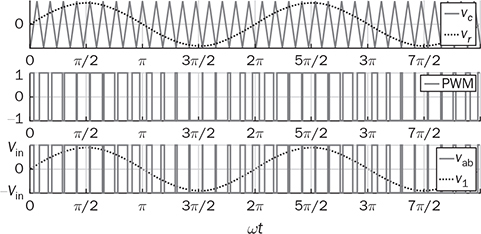DC to single-phase AC conversion has been widely used for battery-powered power supplies. The device to perform DC/AC conversion is often called an inverter. The examples include the uninterrupted power supplies (UPS) for critical loads and inverters powered by car batteries. Such systems generally work on low power capacity to supply single-phase AC directly to loads. Figure 5.1 illustrates two types of UPS: offline and online. FIGURE 5.1 Block diagram of uninterrupted power supplies: (a) standby; (b) online. In the offline system or so-called standby UPS, the single-pole-double-throw (SPDT) relay connects the critical load with the grid supply, as shown in Fig. 5.1a. The battery bank remains charged through a charger, which performs AC/DC conversion when the grid supply is available. When a power outage happens, the DC to single-phase AC is activated to convert DC power from the battery and supply critical AC loads. The DC/AC inverter is mostly standby without any power conversion. The drawback of standby UPS lies in the transition time of the SPDT and the start-up of the inverter. A short-time delay is always present during the transition from the grid to the inverter output. The delay is short enough to keep desktop computers working without any interruption. Solid-state relays are constructed by power semiconductors that can shorten the transition time to replace the mechanical relay. The online UPS system can eliminate the transition time and make the DC/AC converter work full-time to support the load, as shown in Fig. 5.1b. The battery bank becomes a DC interlink between the charger and the DC/AC conversion. During a sudden power outage, the charger stops to operate but the DC/AC conversion is not interrupted and shows a seamless transition. However, the stress on both the AC/DC and DC/AC converters is high due to the full-time power process. The solution generally costs higher than the standby counterpart. The DC/AC conversion for UPS belongs to the stand-alone systems that provide power to single-phase AC loads and maintain the output voltage and frequency. Nowadays, another category of DC to single-phase AC conversion is used for the AC grid interconnection with renewable energy resources. The most common application is the photovoltaic (PV) grid-tied system, which has grown dramatically for home and building installations around the world. Figure 5.2 shows a simplified system diagram, where the PV generator produces DC power. The solar power is converted to single-phase AC and then injected into the public power distribution network. FIGURE 5.2 Simple version of grid-tied PV power system. The most common topology is the active four-switch bridge for DC to single-phase AC conversion, which has been introduced in Sec. 2.4 and illustrated in Fig. 2.15b. The bridge topology is typically constructed by either field effect transistors (FETs) or insulated gate bipolar transistors (IGBTs), as shown in Fig. 5.3. The switch selection depends on the power and voltage level, as discussed in Sec. 2.3.5. The four-switch bridge is formed by two legs in parallel, marked as A and B. The AC output is expressed by vab = vag − vbg, where vag and vbg show the voltage potential to the common DC ground of Leg A and Leg B, respectively. The voltage potential difference leads to the AC output, vab. When one switch is turned on, another in the same leg should be synchronously switched off to avoid any cross conduction or shoot through. FIGURE 5.3 Bridges for DC to single-phase AC conversion by (a) FETs; (b) IGBTs. The on/off switching is feasible to produce square waveforms. The diagonal switching patterns of the four-switch bridge can produce either the positive or negative output at the AC terminal, as illustrated in Fig. 5.4. For the positive cycle, the output is vab = Vin − 0 = Vin formed by the conduction of the diagonal pair of SAH and SBL. The onstate of SBH and SAL leads to the negative cycle, where vab = 0 − Vin = −Vin. The output voltage, vab, becomes an AC waveform when the two cycles are equally split, as shown in Fig. 5.5. The simple switching mechanism starts the DC to single-phase AC conversion. FIGURE 5.4 Diagonal conduction of four-switch bridges for DC/AC conversion: (a) [+] state; (b) [−] state. FIGURE 5.5 Square AC waveform produced by active four-switch bridge. The switching operation is simple to produce square AC waveforms through the four-switch bridge and follow a specified frequency, e.g., 50 or 60 Hz. Nevertheless, the modulation is incapable of regulating the output AC voltage, vab. The amplitude and RMS values of vab are fixed to the DC level of Vin. Based on the four-switch bridge in Fig. 5.3, another two switching states can be achieved to produce cycles with zero output voltage. Figure 5.6 illustrates the two states, which are also called the flat switching pattern. Either the high-side or low-side switches are on-state at the same time, which leads to vab = vag − vbg = 0. The zero states are defined as [H0] and [L0] to distinguish the on-states of both high-side switches and low-side switches, respectively. When the two zero states are introduced in between the state [+] and state [−], the chopped square waveform can be produced for vab, as shown in Fig. 5.7. The marks of T+, T−, and T0 represent the periods of the positive, negative, and zero state, respectively. The RMS value of vab becomes controllable by adjusting the state periods. FIGURE 5.6 Flat conduction states of the four-switch bridge for DC/AC conversion: (a) [H0] state; (b) [L0] state. FIGURE 5.7 Chopped square AC waveform produced by four-switch bridge. Modulation can generate the switching sequence described as the following: 1. SAH switched on ⇒ SAL off ⇒ vag = Vin & vbg = 0 ⇒ vab = Vin ⇒ state [+]. 2. SBH switched on ⇒ SBL off ⇒ vag = Vin & vbg = Vin ⇒ vab = 0 ⇒ state [H0]. 3. SAH switched off ⇒ SAL on ⇒ vag = 0 & vbg = Vin ⇒ vab = −Vin ⇒ state [−]. 4. SBH switched off ⇒ SBL on ⇒ vag = 0 & vbg = 0 ⇒ vab = 0 ⇒ state [L0]. At each switching moment, one switch is turned on, and another on the same leg is automatically turned off. Each switch maintains on-state for half cycle or 50% duty cycle, which results in rectangular waveforms of vag and vbg. A time delay is applied between the switching-on of SAH and SBH. The time delay represents the period of the positive state, which is equal to that of the negative state. Figure 5.8 demonstrates the equivalent circuits in response to the switching sequence. FIGURE 5.8 Switching sequence to produce chopped square waveform. The above operation can be explained in the phase domain, as shown in Fig. 5.9. Phase shift between two rectangular waves is a common modulation technique that can produce the chopped square waveform for the DC to single-phase AC conversion. The phase value is represented by Φ for analysis, which is indicated in Fig. 5.9. The pulse width of the states [+] and [−] corresponds with Φ in each 2π cycle. The zero states, [H0] and [L0], lead to zero output voltage. The RMS value of the output AC voltage is regulated by the phase-shift angle. Based on one half-cycle in steady state and the waveform shown in Fig. 5.9, the RMS value of vab can be derived by When Φ = 0, the rectangular waveforms of vag and vbg are overlapped and result in zero output of vab. When Φ = π, the square waveform appears and represents the highest voltage conversion ratio from DC to single-phase AC. When FIGURE 5.9 Phase shift to produce single-phase AC waveform. FIGURE 5.10 Equivalence of sine wave with chopped square waveform. To match and compare with the sine wave, the pulse of the chopped square waveform is centered in each half-cycle, as shown in Fig. 5.10, when The phase shift technology can modulate the four-switch bridge to produce single-phase AC output with controllable voltage output. The main concern results from the distortion in comparison with the ideal AC signal in power systems. The total harmonic distortion (THD) has been introduced in Sec. 4.5.2 to quantify the difference. For the chopped square waveform, vab, the Fourier transform (FT) series is expressed by where the fundamental frequency refers to ω0, and the odd number of harmonics is counted. The amplitudes for the n odd harmonic component of the chopped square waveform is expressed by (5.4). The amplitude and RMS value for the fundamental component, v1, can be derived as in (5.5) and (5.6). According to the THD definition for voltage in (4.24), the value for the chopped square waveform can be determined by where RMS(vab) and RMS(v1) can be determined by (5.2) and (5.6), respectively. Figure 5.11 illustrates the correlation between the THD value and the modulation index, the margin angle of α. The THD value of the pure square waveform when α = 0 has been discussed in Sec. 4.5.2, which is rated as 48.43 percent. The region when FIGURE 5.11 Conversion ratio of chopped square waveforms. The chopped square AC waveform is commonly used as the output of the low-cost and low-capacity AC power supplies because of the simple phase-shift modulation at relatively low frequency. The power supply is usually sourced from rechargeable batteries, e.g., from cars, and provides power to many household AC appliances. The DC to single-phase AC conversion is commonly called the “modified sine wave inverter,” which refers to the output of the chopped square waveform for AC. However, the THD level of the square-like waveforms is always higher than 20%, which cannot be accepted by various industry standards, especially for high-capacity AC power supply or grid interconnection. Industry demands high-quality AC output from the DC/AC conversion. The technique of pulse width modulation at high frequency and low-pass filtering can be utilized to achieve the goal. Industry sometimes calls such DC/AC conversion the “pure sine wave inverter.” The modulation technology is commonly called the sinusoidal pulse width modulation (SPWM). The PWM operation has been introduced in Sec. 3.1 and illustrated in Fig. 3.2 for the DC/DC conversion. Regarding DC/AC conversion, the same comparison mechanism can be applied with the variation in the reference and carrier signals. The applied signal for the reference should reflect the nature of AC voltage output, which carries the fundamental frequency. The bipolar pulse width modulation (BPWM) is a straightforward way to manipulate switching pulse for the DC/AC conversion. The carrier signal, vc, shows bipolar triangle waveform, including the positive and negative half cycle, as illustrated in Fig. 5.12. The reference signal, vr, is a sine waveform, which reflects the fundamental frequency of the AC output, ω. The frequency of vc is higher than ω to produce fine PWM pulses. The comparison between vr and vc produces the PWM signal, as shown in Fig. 5.12. FIGURE 5.12 Demonstration of bipolar PWM operation and output waveform. When vr > vc, the PWM outputs ‘1’ and controls the diagonal switch pair of SAH and SBL to conduct, as illustrated by the equivalent circuit in Fig. 5.4a
CHAPTER 5

DC to Single-Phase AC Conversion



5.1 Square Wave AC
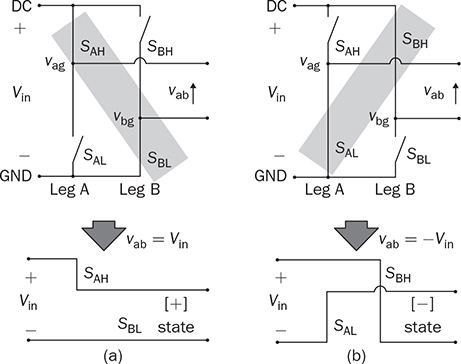

5.1.1 Chopping
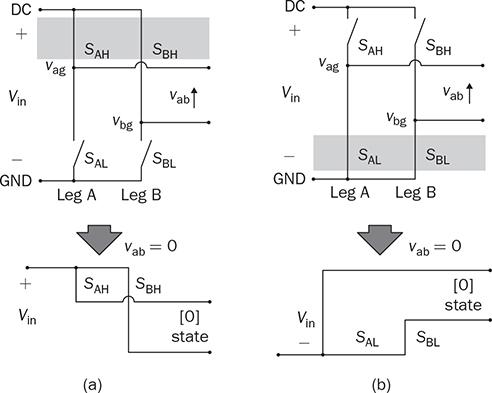

5.1.2 Phase Shift and Modulation
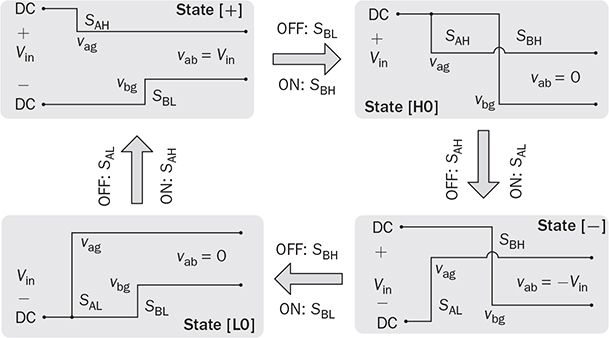

 the RMS value is determined as
the RMS value is determined as 
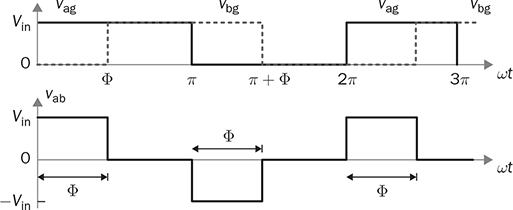
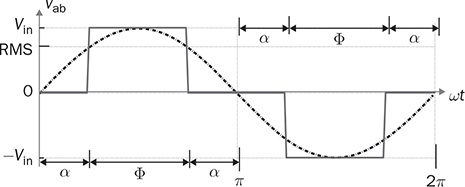
 The margin angle, α, is defined to represent half of the zero states (T0). Both Φ or α can be the modulation index for the output voltage regulation since the relation is defined as 2α + Φ = π. Therefore, the RMS value of the output voltage can also be derived as in (5.2), which is equivalent to (5.1). Thus, the output voltage can be regulated by adjusting either α or Φ.
The margin angle, α, is defined to represent half of the zero states (T0). Both Φ or α can be the modulation index for the output voltage regulation since the relation is defined as 2α + Φ = π. Therefore, the RMS value of the output voltage can also be derived as in (5.2), which is equivalent to (5.1). Thus, the output voltage can be regulated by adjusting either α or Φ.

5.1.3 Total Harmonic Distortion





 shows better representation of the ideal AC signal due to the relatively lower THD.
shows better representation of the ideal AC signal due to the relatively lower THD.
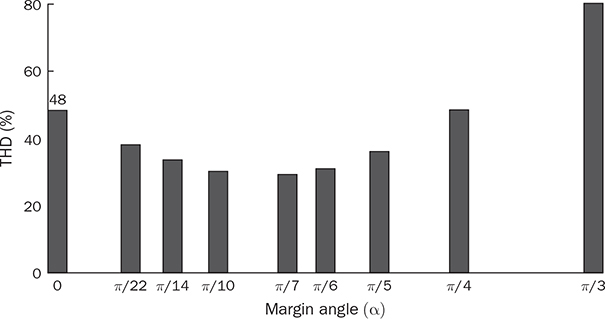
5.2 Sine-Triangle Modulation
5.2.1 Bipolar Pulse Width Modulation
